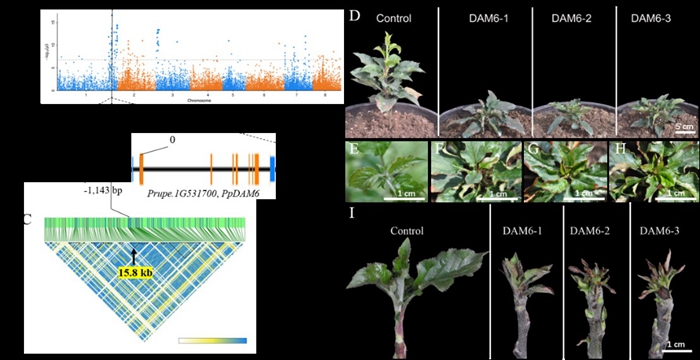Key gene controlling peach chilling requirement was discovered
Recently, the Peach Resource and Breeding Group of Zhengzhou Fruit Research Institute, Chinese Academy of Agricultural Sciences (CAAS) has identified a key gene, PpDAM6 , controlling peach chilling requirement (CR) by genome-wide association analysis based on structural variations (SVs), and developed a low CR breeding marker based on this gene. CR is an important agronomic trait of peach, and low CR is the key difficulty for the development of peach industry in southern China. The results of this study provide a guarantee for molecular breeding of low CR. The result was published on May 22 in Plant Physiology.

Genome-wide association study (GWAS) and expression analysis of key candidate genes for chilling requirement control in peach
CR is a necessary condition to break dormancy of deciduous fruit trees. Failure to meet CR will lead to late flowering, long flowering duration or even no flowering, thus reducing yield and fruit commerciality. Peach is a tree with intensely strict request to CR, therefore it is an excellent material for studying CR control gene. Previous studies have identified several QTLs for CR, but the key genes controlling CR remain unclear.
In this study, 345 peach natural population accessions with different CRs were used as materials, and a major gene was identified by genome-wide structural variation GWAS analysis. The 30-bp structural variation in the promoter region of this gene was highly correlated with CR phenotype, and 30-bp deletion only existed in cultivars with low CR. Based on this reason, a molecular marker of low CR was developed. In addition, PpDAM6 has been found to influence the dormancy release by mediating the expression of downstream ABA biosynthesis gene and callose deposition among dormancy cells. The results of this study further enriched the understanding of the molecular mechanism of dormancy regulation by the control gene of CR, and also provided important gene and variation resources for breeding peach cultivars with low CR.
This research was supported by the Youth Project of the National Natural Science Foundation of China, the Youth Innovation Project of the Chinese Academy of Agricultural Sciences, the Science and Technology Innovation Project of the Chinese Academy of Agricultural Sciences, and the Crop Germplasm Resources Protection Project.
The paper link: https://doi.org/10.1093/plphys/kiad291
By Li Yong
Liyong02@caas.cn
-
 Apr 18, 2024Opening Ceremony of the Training Workshop on Wheat Head Scab Resistance Breeding and Pest Control in Africa Held in CAAS
Apr 18, 2024Opening Ceremony of the Training Workshop on Wheat Head Scab Resistance Breeding and Pest Control in Africa Held in CAAS -
 Apr 03, 2024IPPCAAS Co-organized the Training Workshop on Management and Application of Biopesticides in Nepal
Apr 03, 2024IPPCAAS Co-organized the Training Workshop on Management and Application of Biopesticides in Nepal -
 Mar 28, 2024Delegation from the School of Agriculture and Food Science of University College Dublin, Ireland Visit to IAS, CAAS
Mar 28, 2024Delegation from the School of Agriculture and Food Science of University College Dublin, Ireland Visit to IAS, CAAS -
 Mar 25, 2024Director of World Food Prize Foundation visited GSCAAS
Mar 25, 2024Director of World Food Prize Foundation visited GSCAAS -
 Mar 20, 2024Institute of Crop Sciences (ICS) and Syngenta Group Global Seeds Advance Collaborative Research in the Seed Industry
Mar 20, 2024Institute of Crop Sciences (ICS) and Syngenta Group Global Seeds Advance Collaborative Research in the Seed Industry
